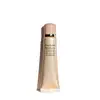What's inside
What's inside
 Key Ingredients
Key Ingredients

 Benefits
Benefits

 Concerns
Concerns

 Ingredients Side-by-side
Ingredients Side-by-side

Diisostearyl Malate
EmollientMicrocrystalline Wax
Emulsion StabilisingGlyceryl Diisostearate
EmollientPolymethyl Methacrylate
Triisostearin
Skin ConditioningPEG/PPG-36/41 Dimethyl Ether
Skin ConditioningWater
Skin ConditioningDextrin Palmitate
EmulsifyingDipropylene Glycol
HumectantGlycerin
HumectantGlucosyl Hesperidin
HumectantSorbitan Sesquiisostearate
EmulsifyingMica
Cosmetic ColorantCI 77891
Cosmetic ColorantMenthol
MaskingRetinyl Acetate
Skin ConditioningTocopherol
AntioxidantStearyl Glycyrrhetinate
Skin ConditioningTocopheryl Acetate
AntioxidantHelianthus Annuus Seed Oil
EmollientButylene Glycol
HumectantDimethicone
EmollientParfum
MaskingCI 77491
Cosmetic ColorantBHT
AntioxidantPolyglyceryl-2 Triisostearate
EmulsifyingChlorella Vulgaris Extract
Skin ConditioningSoluble Collagen
HumectantMethicone
EmollientTetradecene
EmollientPhenoxyethanol
PreservativeDiisostearyl Malate, Microcrystalline Wax, Glyceryl Diisostearate, Polymethyl Methacrylate, Triisostearin, PEG/PPG-36/41 Dimethyl Ether, Water, Dextrin Palmitate, Dipropylene Glycol, Glycerin, Glucosyl Hesperidin, Sorbitan Sesquiisostearate, Mica, CI 77891, Menthol, Retinyl Acetate, Tocopherol, Stearyl Glycyrrhetinate, Tocopheryl Acetate, Helianthus Annuus Seed Oil, Butylene Glycol, Dimethicone, Parfum, CI 77491, BHT, Polyglyceryl-2 Triisostearate, Chlorella Vulgaris Extract, Soluble Collagen, Methicone, Tetradecene, Phenoxyethanol
Bis-Diglyceryl Polyacyladipate-2
EmollientHydrogenated Castor Oil Dimer Dilinoleate
Skin ConditioningCaprylic/Capric Triglyceride
MaskingSqualane
EmollientRicinus Communis Seed Oil
MaskingHelianthus Annuus Seed Wax
Skin ConditioningSimmondsia Chinensis Seed Oil
EmollientPolyglyceryl-2 Triisostearate
EmulsifyingPolyhydroxystearic Acid
EmulsifyingC10-18 Triglycerides
EmollientCellulose
AbsorbentButyrospermum Parkii Butter
Skin ConditioningDipalmitoyl Hydroxyproline
Skin ConditioningTribehenin
EmollientTheobroma Cacao Seed Butter
EmollientSucrose Tetrastearate Triacetate
EmollientButylene Glycol
HumectantSilica Dimethyl Silylate
EmollientEuphorbia Cerifera Wax
Cetyl PEG/PPG-10/1 Dimethicone
EmulsifyingHydrolyzed Ginseng Saponins
Skin ConditioningDiphenyl Dimethicone
EmollientParfum
MaskingPanax Ginseng Seed Oil
EmollientCitronellol
PerfumingLinalool
PerfumingGeraniol
PerfumingLimonene
PerfumingWater
Skin ConditioningPropanediol
SolventPentaerythrityl Tetra-Di-T-Butyl Hydroxyhydrocinnamate
AntioxidantPanax Ginseng Root Extract
EmollientHoney
HumectantRehmannia Glutinosa Root Extract
Skin ConditioningPaeonia Lactiflora Root Extract
Skin ConditioningLilium Candidum Bulb Extract
Skin ConditioningPolygonatum Odoratum Rhizome Extract
Skin ConditioningNelumbo Nucifera Flower Extract
Skin ConditioningBis-Diglyceryl Polyacyladipate-2, Hydrogenated Castor Oil Dimer Dilinoleate, Caprylic/Capric Triglyceride, Squalane, Ricinus Communis Seed Oil, Helianthus Annuus Seed Wax, Simmondsia Chinensis Seed Oil, Polyglyceryl-2 Triisostearate, Polyhydroxystearic Acid, C10-18 Triglycerides, Cellulose, Butyrospermum Parkii Butter, Dipalmitoyl Hydroxyproline, Tribehenin, Theobroma Cacao Seed Butter, Sucrose Tetrastearate Triacetate, Butylene Glycol, Silica Dimethyl Silylate, Euphorbia Cerifera Wax, Cetyl PEG/PPG-10/1 Dimethicone, Hydrolyzed Ginseng Saponins, Diphenyl Dimethicone, Parfum, Panax Ginseng Seed Oil, Citronellol, Linalool, Geraniol, Limonene, Water, Propanediol, Pentaerythrityl Tetra-Di-T-Butyl Hydroxyhydrocinnamate, Panax Ginseng Root Extract, Honey, Rehmannia Glutinosa Root Extract, Paeonia Lactiflora Root Extract, Lilium Candidum Bulb Extract, Polygonatum Odoratum Rhizome Extract, Nelumbo Nucifera Flower Extract
 Reviews
Reviews

Ingredients Explained
These ingredients are found in both products.
Ingredients higher up in an ingredient list are typically present in a larger amount.
Butylene Glycol (or BG) is used within cosmetic products for a few different reasons:
Overall, Butylene Glycol is a safe and well-rounded ingredient that works well with other ingredients.
Though this ingredient works well with most skin types, some people with sensitive skin may experience a reaction such as allergic rashes, closed comedones, or itchiness.
Learn more about Butylene GlycolParfum is a catch-all term for an ingredient or more that is used to give a scent to products.
Also called "fragrance", this ingredient can be a blend of hundreds of chemicals or plant oils. This means every product with "fragrance" or "parfum" in the ingredients list is a different mixture.
For instance, Habanolide is a proprietary trade name for a specific aroma chemical. When used as a fragrance ingredient in cosmetics, most aroma chemicals fall under the broad labeling category of “FRAGRANCE” or “PARFUM” according to EU and US regulations.
The term 'parfum' or 'fragrance' is not regulated in many countries. In many cases, it is up to the brand to define this term.
For instance, many brands choose to label themselves as "fragrance-free" because they are not using synthetic fragrances. However, their products may still contain ingredients such as essential oils that are considered a fragrance by INCI standards.
One example is Calendula flower extract. Calendula is an essential oil that still imparts a scent or 'fragrance'.
Depending on the blend, the ingredients in the mixture can cause allergies and sensitivities on the skin. Some ingredients that are known EU allergens include linalool and citronellol.
Parfum can also be used to mask or cover an unpleasant scent.
The bottom line is: not all fragrances/parfum/ingredients are created equally. If you are worried about fragrances, we recommend taking a closer look at an ingredient. And of course, we always recommend speaking with a professional.
Learn more about ParfumThis ingredient is a form of glycerin with emulsifying and emollient properties.
As an emulsifier, this ingredient helps keep products together while adding a thick texture. The manufacturer states this ingredient has emollient properties. Emollients help keep the skin hydrated by trapping moisture in.
Polyglyceryl-2 Triisostearate is created by reacting diglycerin and isostearic acid. Due to the isostearic acid base, it may not be safe for Malassezia or fungal acne.
Learn more about Polyglyceryl-2 TriisostearateWater. It's the most common cosmetic ingredient of all. You'll usually see it at the top of ingredient lists, meaning that it makes up the largest part of the product.
So why is it so popular? Water most often acts as a solvent - this means that it helps dissolve other ingredients into the formulation.
You'll also recognize water as that liquid we all need to stay alive. If you see this, drink a glass of water. Stay hydrated!
Learn more about Water